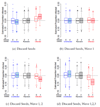Respondent-Driven Sampling: An Assessment of Current Methodology
- PMID: 22969167
- PMCID: PMC3437336
- DOI: 10.1111/j.1467-9531.2010.01223.x
Respondent-Driven Sampling: An Assessment of Current Methodology
Abstract
Respondent-Driven Sampling (RDS) employs a variant of a link-tracing network sampling strategy to collect data from hard-to-reach populations. By tracing the links in the underlying social network, the process exploits the social structure to expand the sample and reduce its dependence on the initial (convenience) sample.The current estimators of population averages make strong assumptions in order to treat the data as a probability sample. We evaluate three critical sensitivities of the estimators: to bias induced by the initial sample, to uncontrollable features of respondent behavior, and to the without-replacement structure of sampling.Our analysis indicates: (1) that the convenience sample of seeds can induce bias, and the number of sample waves typically used in RDS is likely insufficient for the type of nodal mixing required to obtain the reputed asymptotic unbiasedness; (2) that preferential referral behavior by respondents leads to bias; (3) that when a substantial fraction of the target population is sampled the current estimators can have substantial bias.This paper sounds a cautionary note for the users of RDS. While current RDS methodology is powerful and clever, the favorable statistical properties claimed for the current estimates are shown to be heavily dependent on often unrealistic assumptions. We recommend ways to improve the methodology.
Figures











References
-
- Abdul-Quader Abu S, Heckathorn Douglas D, McKnight Courtney, Bramson Heidi, Nemeth Chris, Sabin Keith, Gallagher Kathleen, Des Jarlais Don C. Effectiveness of Respondent-Driven Sampling for Recruiting Drug Users in New York City: Findings from a Pilot Study. Journal of Urban Health. 2006;83:459–476. - PMC - PubMed
-
- Barndorff-Nielsen Ole E. Information and Exponential Families in Statistical Theory. New York: Wiley; 1978.
-
- Bernhardt Annette, Heckathorn Douglas, Milkman Ruth, Theodore Nikolas. Documenting Unregulated Work: A Survey of Workplace Violations in New York City. The Future of Work. 2006
-
- CDC Consultation. Consultation on Respondent-Driven Sampling: Discussion. Atlanta, Georgia: 2008. Feb 12,
-
- Persi Diaconis. The Markov chain Monte Carlo revolution. Bulletin of the American Mathematical Society. 2009;46:179–205.
Grants and funding
LinkOut - more resources
Full Text Sources
Medical
